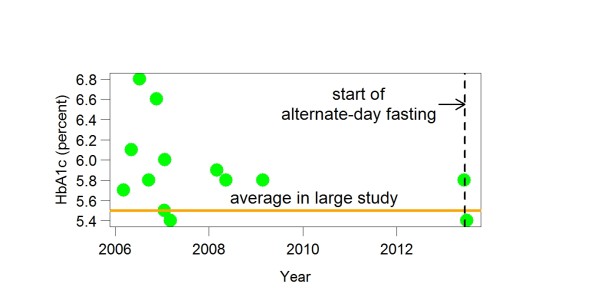This graph shows my HbA1c values in recent years. After a lot of variation, they settled down to 5.8, which was the measurement a month ago. 5.8 isn’t terrible — below 6.0 is sometimes called “okay”) — but there is room for improvement. In a large 2010 study, average HbA1c was 5.5. The study suggested that a HbA1c of about 5.0 was ideal.
Three weeks ago I started alternate-day fasting (= eating much less than usual every other day) for entirely different reasons. Although people sometimes find alternate-day fasting unpleasant (they get too hungry on the fast days), I haven’t noticed this. I blogged recently that within days of starting, my fasting blood sugar levels greatly improved. Yesterday I got my HbA1c measured again. It was 5.4 — much better. This supports the idea that alternate-day fasting is helping a lot. HbA1c measures glucose in the blood over 8-12 weeks so there could easily be more improvement.
“Whether intermittent fasting can be used as a tool to prevent diabetes in those individuals at high risk or to prevent progression in those recently diagnosed with Type 2 diabetes remains a tantalizing notion,” said an author of a recent paper on the subject. My experience suggests that you can easily find out for yourself if intermittent fasting will help. It took only a week to be sure that my fasting blood sugar had improved and only three weeks to have a good idea that my HbA1c has improved. My improvement was almost as fast and clear as what happens when people with a vitamin deficiency are given the vitamin they need.
There are countless ways of doing alternate-day fasting (or, more generally, intermittent fasting). A clinical trial usually tests just one way, which you may not want to copy exactly. My results suggest that blood sugar measurements provide an easy way to tell if your particular version of intermittent fasting is helping.

If the green dots are your previous level, they show high variability as well as sudden, precipitous drops.
Your current results don’t support anything.
Seth: Time will tell.
I thought that was a bit curious too. In the end of 2006/beginning of 2007 your HbA1c dropped more than 1 point. What was the interval between those 2 readings & what did you do during that time?
Seth: The interval was 3.5 months. I can’t remember what I did but probably reduced my high-GI carb intake. The early years of these readings are the first years the service was offered. I was surprised by the high values and probably changed what I ate, but it is also possible that the measurement method improved (e.g., the calibration improved).
note that this measure gives an average of the last three months of blood sugar.
so it lags……
Seth, when doing alternate day fasting, how do you continue eating flax seeds/oil and butter if you’re fasting every other day?
Seth: I eat them on the fasting days. If you look at alternate-day fasting protocols, they usually include 500 calories or so on the fasting days.